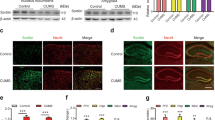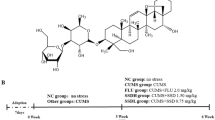Abstract
Background
Depression is a severe mental disorder. Unfortunately, more than half of patients with major depression disorder cannot achieve remission after initial treatment with an antidepressant. Geniposide, a bioactive iridoid glycoside isolated from Gardenia jasminoides Ellis, can ameliorate depressive-like behaviors in mice. However, the underlying mechanism is still not very clear.
Methods
The pharmacological methods including ELISA, immunofluorescence, and Western blot were used to investigate the role of geniposide on chronic unpredictable mild stress (CUMS)-induced depression mice.
Results
In this study, we found that geniposide could inhibit CUMS-induced depressive-like behaviors in mice. Geniposide is able to reduce the levels of ceramide and lower the activity of acid sphingomyelinase (ASM) in hippocampus; besides, ASM inhibitor (amitriptyline) can decrease the concentration of ceramide and ameliorate depressive-like behaviors of mice. Moreover, geniposide can also alleviate CUMS-induced hippocampal neuronal apoptosis and increase the phosphorylated form of PI3K, Akt, and GSK3β. Additionally, PI3K inhibitor (LY294002) can also abolish the neuroprotective effect of geniposide on hippocampal neurons in vitro.
Conclusions
These results indicate that geniposide exert a potential antidepressant-like effect on CUMS mice, and its effect might be associated with activated PI3K/Akt/GSK3β signaling, reduced the level of ceramide and hippocampal neuron apoptosis.






Similar content being viewed by others
References
Arboleda G, Cardenas Y, Rodriguez Y, Morales LC, Matheus L, Arboleda H (2010) Differential regulation of AKT, MAPK and GSK3beta during C2-ceramide-induced neuronal death. Neurotoxicology 31:687–693
Belmaker RH, Agam G (2008) Major depressive disorder. N Engl J Med 358:55–68
Bienias K, Fiedorowicz A, Sadowska A, Prokopiuk S, Car H (2016) Regulation of sphingomyelin metabolism. Pharmacol Rep 68:570–581
Bikman BT, Summers SA (2011) Ceramides as modulators of cellular and whole-body metabolism. J Clin Invest 121:4222–4230
Cai L, Li R, Tang WJ, Meng G, Hu XY, Wu TN (2015) Antidepressant-like effect of geniposide on chronic unpredictable mild stress-induced depressive rats by regulating the hypothalamus-pituitary-adrenal axis. Eur Neuropsychopharmacol 25:1332–1341
Can A, Dao DT, Terrillion CE, Piantadosi SC, Bhat S, Gould TD (2012) The tail suspension test. J Vis Exp e3769
Chaurasia B, Summers SA (2015) Ceramides - lipotoxic inducers of metabolic disorders. Trends Endocrinol Metab 26:538–550
Chen Y, Zhang Y, Li L, Holscher C (2015) Neuroprotective effects of geniposide in the MPTP mouse model of Parkinson’s disease. Eur J Pharmacol 768:21–27
Cipriani A, Furukawa TA, Salanti G, Geddes JR, Higgins JP, Churchill R, Watanabe N, Nakagawa A, Omori IM, McGuire H, Tansella M, Barbui C (2009) Comparative efficacy and acceptability of 12 new-generation antidepressants: a multiple-treatments meta-analysis. Lancet 373:746–758
Elmore S (2007) Apoptosis: a review of programmed cell death. Toxicol Pathol 35:495–516
Gao C, Liu Y, Jiang Y, Ding J, Li L (2014) Geniposide ameliorates learning memory deficits, reduces tau phosphorylation and decreases apoptosis via GSK3beta pathway in streptozotocin-induced alzheimer rat model. Brain Pathol 24:261–269
Gillard BK, Clement RG, Marcus DM (1998) Variations among cell lines in the synthesis of sphingolipids in de novo and recycling pathways. Glycobiology 8:885–890
Gomez-Munoz A, Presa N, Gomez-Larrauri A, Rivera IG, Trueba M, Ordonez M (2016) Control of inflammatory responses by ceramide, sphingosine 1-phosphate and ceramide 1-phosphate. Prog Lipid Res 61:51–62
Grassme H, Jekle A, Riehle A, Schwarz H, Berger J, Sandhoff K, Kolesnick R, Gulbins E (2001a) CD95 signaling via ceramide-rich membrane rafts. J Biol Chem 276:20589–20596
Grassme H, Schwarz H, Gulbins E (2001b) Molecular mechanisms of ceramide-mediated CD95 clustering. Biochem Biophys Res Commun 284:1016–1030
Gulbins A, Grassme H, Hoehn R, Wilker B, Soddemann M, Kohnen M, Edwards MJ, Kornhuber J, Gulbins E (2016) Regulation of neuronal stem cell proliferation in the hippocampus by endothelial ceramide. Cell Physiol Biochem 39:790–801
Gulbins E, Palmada M, Reichel M, Luth A, Bohmer C, Amato D, Muller CP, Tischbirek CH, Groemer TW, Tabatabai G, Becker KA, Tripal P, Staedtler S, Ackermann TF, van Brederode J, Alzheimer C, Weller M, Lang UE, Kleuser B, Grassme H, Kornhuber J (2013) Acid sphingomyelinase-ceramide system mediates effects of antidepressant drugs. Nat Med 19:934–938
Gulbins E, Walter S, Becker KA, Halmer R, Liu Y, Reichel M, Edwards MJ, Muller CP, Fassbender K, Kornhuber J (2015) A central role for the acid sphingomyelinase/ceramide system in neurogenesis and major depression. J Neurochem 134:183–192
Guo LT, Wang SQ, Su J, Xu LX, Ji ZY, Zhang RY, Zhao QW, Ma ZQ, Deng XY, Ma SP (2019) Baicalin ameliorates neuroinflammation-induced depressive-like behavior through inhibition of toll-like receptor 4 expression via the PI3K/AKT/FoxO1 pathway. J Neuroinflammation 16:95
Hait NC, Maiti A (2017) The role of sphingosine-1-phosphate and ceramide-1-phosphate in inflammation and cancer. Mediators Inflamm 2017:4806541
Hannun YA, Obeid LM (2008) Principles of bioactive lipid signalling: lessons from sphingolipids. Nat Rev Mol Cell Biol 9:139–150
Henn FA, Vollmayr B (2004) Neurogenesis and depression: etiology or epiphenomenon? Biol Psychiatry 56:146–150
Herget T, Esdar C, Oehrlein SA, Heinrich M, Schutze S, Maelicke A, van Echten-Deckert G (2000) Production of ceramides causes apoptosis during early neural differentiation in vitro. J Biol Chem 275:30344–30354
Hoehn R, Monse M, Pohl E, Wranik S, Wilker B, Keitsch S, Soddemann M, Kornhuber J, Kohnen M, Edwards MJ, Grassme H, Gulbins E (2016) Melatonin acts as an antidepressant by inhibition of the acid sphingomyelinase/ceramide system. Neurosignals 24:48–58
Hsieh CT, Chuang JH, Yang WC, Yin Y, Lin Y (2014) Ceramide inhibits insulin-stimulated Akt phosphorylation through activation of Rheb/mTORC1/S6K signaling in skeletal muscle. Cell Signal 26:1400–1408
Huang B, Chen P, Huang L, Li S, Zhu R, Sheng T, Yu W, Chen Z, Wang T (2017) Geniposide attenuates post-ischaemic neurovascular damage via GluN2A/AKT/ ERK-dependent mechanism. Cell Physiol Biochem 43:705–716
Jacobson L, Sapolsky R (1991) The role of the hippocampus in feedback regulation of the hypothalamic-pituitary-adrenocortical axis. Endocr Rev 12:118–134
JazvinscakJembrek M, Hof PR, Simic G (2015) Ceramides in Alzheimer’s disease: key mediators of neuronal apoptosis induced by oxidative stress and abeta accumulation. Oxid Med Cell Longev 2015:346783
Jenkins GM, Cowart LA, Signorelli P, Pettus BJ, Chalfant CE, Hannun YA (2002) Acute activation of de novo sphingolipid biosynthesis upon heat shock causes an accumulation of ceramide and subsequent dephosphorylation of SR proteins. J Biol Chem 277:42572–42578
Kitatani K, Idkowiak-Baldys J, Hannun YA (2008) The sphingolipid salvage pathway in ceramide metabolism and signaling. Cell Signal 20:1010–1018
Kornhuber J, Muller CP, Becker KA, Reichel M, Gulbins E (2014) The ceramide system as a novel antidepressant target. Trends Pharmacol Sci 35:293–304
Koshkaryev A, Piroyan A, Torchilin VP (2012) Increased apoptosis in cancer cells in vitro and in vivo by ceramides in transferrin-modified liposomes. Cancer Biol Ther 13:50–60
Law BA, Liao X, Moore KS, Southard A, Roddy P, Ji R, Szulc Z, Bielawska A, Schulze PC, Cowart LA (2018) Lipotoxic very-long-chain ceramides cause mitochondrial dysfunction, oxidative stress, and cell death in cardiomyocytes. FASEB J 32:1403–1416
Liu S, Xu S, Wang Z, Guo Y, Pan W, Shen Z (2018) Anti-depressant-like effect of sinomenine on chronic unpredictable mild stress-induced depression in a mouse model. Med Sci Monit 24:7646–7653
Liu F, Wang Y, Yao W, Xue Y, Zhou J, Liu Z (2019) Geniposide attenuates neonatal mouse brain injury after hypoxic-ischemia involving the activation of PI3K/Akt signaling pathway. J Chem Neuroanat 102:101687
Mrazek DA, Hornberger JC, Altar CA, Degtiar I (2014) A review of the clinical, economic, and societal burden of treatment-resistant depression: 1996–2013. Psychiatr Serv 65:977–987
Rakel RE (1999) Depression. Prim Care 26:211–224
Rhein C, Reichel M, Kramer M, Rotter A, Lenz B, Muhle C, Gulbins E, Kornhuber J (2017) Alternative splicing of SMPD1 coding for acid sphingomyelinase in major depression. J Affect Disord 209:10–15
Ruvolo PP, Deng X, Ito T, Carr BK, May WS (1999) Ceramide induces Bcl2 dephosphorylation via a mechanism involving mitochondrial PP2A. J Biol Chem 274:20296–20300
Schoenfeld TJ, McCausland HC, Morris HD, Padmanaban V, Cameron HA (2017) Stress and loss of adult neurogenesis differentially reduce hippocampal volume. Biol Psychiatry 82:914–923
Shan M, Yu S, Yan H, Guo S, Xiao W, Wang Z, Zhang L, Ding A, Wu Q, Li SFY (2017) A review on the phytochemistry, pharmacology, pharmacokinetics and toxicology of geniposide, a natural product. Molecules 22:1689
Smith SM, Vale WW (2006) The role of the hypothalamic-pituitary-adrenal axis in neuroendocrine responses to stress. Dialogues Clin Neurosci 8:383–395
Snyder JS, Soumier A, Brewer M, Pickel J, Cameron HA (2011) Adult hippocampal neurogenesis buffers stress responses and depressive behaviour. Nature 476:458–461
Stancevic B, Kolesnick R (2010) Ceramide-rich platforms in transmembrane signaling. FEBS Lett 584:1728–1740
Stetler C, Miller GE (2011) Depression and hypothalamic-pituitary-adrenal activation: a quantitative summary of four decades of research. Psychosom Med 73:114–126
Thomas RL Jr, Matsko CM, Lotze MT, Amoscato AA (1999) Mass spectrometric identification of increased C16 ceramide levels during apoptosis. J Biol Chem 274:30580–30588
Wang G, Dinkins M, He Q, Zhu G, Poirier C, Campbell A, Mayer-Proschel M, Bieberich E (2012) Astrocytes secrete exosomes enriched with proapoptotic ceramide and prostate apoptosis response 4 (PAR-4): potential mechanism of apoptosis induction in Alzheimer disease (AD). J Biol Chem 287:21384–21395
Willaime-Morawek S, Arbez N, Mariani J, Brugg B (2005) IGF-I protects cortical neurons against ceramide-induced apoptosis via activation of the PI-3K/Akt and ERK pathways; is this protection independent of CREB and Bcl-2? Brain Res Mol Brain Res 142:97–106
Xian YF, Ip SP, Li HQ, Qu C, Su ZR, Chen JN, Lin ZX (2019) Isorhynchophylline exerts antidepressant-like effects in mice via modulating neuroinflammation and neurotrophins: involvement of the PI3K/Akt/GSK-3beta signaling pathway. FASEB J 33:10393–10408
Yankelevitch-Yahav R, Franko M, Huly A, Doron R (2015) The forced swim test as a model of depressive-like behavior. J Vis Exp (97):52587
Zhao Y, Li H, Fang F, Qin T, Xiao W, Wang Z, Ma S (2018) Geniposide improves repeated restraint stress-induced depression-like behavior in mice by ameliorating neuronal apoptosis via regulating GLP-1R/AKT signaling pathway. Neurosci Lett 676:19–26
Zhou XY, Zhang F, Ying CJ, Chen J, Chen L, Dong J, Shi Y, Tang M, Hu XT, Pan ZH, Xu NN, Zheng KY, Tang RX, Song YJ (2017) Inhibition of iNOS alleviates cognitive deficits and depression in diabetic mice through downregulating the NO/sGC/cGMP/PKG signal pathway. Behav Brain Res 322:70–82
Funding
This study was supported by Biomedical and Engineering cross youth fund of Shanghai Jiao Tong University (No. YG2021QN43).
Author information
Authors and Affiliations
Corresponding authors
Ethics declarations
Conflict of interest
The authors declare no competing interests.
Additional information
Publisher's note
Springer Nature remains neutral with regard to jurisdictional claims in published maps and institutional affiliations.
Rights and permissions
About this article
Cite this article
Wang, M., Yang, L., Chen, Z. et al. Geniposide ameliorates chronic unpredictable mild stress induced depression-like behavior through inhibition of ceramide-PP2A signaling via the PI3K/Akt/GSK3β axis. Psychopharmacology 238, 2789–2800 (2021). https://doi.org/10.1007/s00213-021-05895-8
Received:
Accepted:
Published:
Issue Date:
DOI: https://doi.org/10.1007/s00213-021-05895-8




